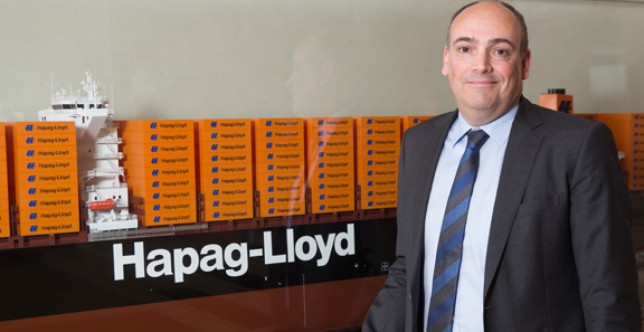The fifth-largest container carrier wants to be “number one for quality” and increase digital initiatives.
Hapag-Lloyd expects to increase profitability and further deleverage the company in 2019, said Rolf Habben Jansen, the company’s chief executive officer, last week in a telephone call with securities analysts.
Habben Jansen (pictured above) said major accomplishments in 2018 included achieving synergies from its 2017 merger with United Arab Shipping Co. ahead of time and beginning to implement a new strategy unveiled last November that takes into account its acquisition of both UASC and its 2014 merger with CSAV.
With that strategy, Hapag-Lloyd said it is striving to improve profits, become “number one for quality” and be a global player in the container industry.
Hapag-Lloyd had a net profit of $54 million in 2018, compared to $36 million in 2017. Revenue was $13.6 million in 2018 compared to $11.3 million on 2017.
Among the profit initiatives Habben Jansen highlighted was a successful pilot project in Singapore, Jebel Ali and Colombo to cooperate more closely with container terminals, including through enhanced sharing of data to obtain faster and more efficient handling of ships.
The company also is rolling out improvements in procurement, focusing on transport services, on which it spends $1 billion per year, on a worldwide basis following a successful pilot in Asia and Europe.
“This is not only about trying to get lower rates, but also trying to get the right modal split and trying to optimize the way we organize the transport,” said Habben Jansen.
The Hamburg, Germany-headquartered carrier also is prioritizing initiatives to reduce empty container moves on which it also spends about $1 billion annually.
Quality initiatives include an effort to increase digital booking of cargo on Hapag-Lloyd’s web channel, currently at 7 percent, and developing new digital services.
The company has expanded its quality center in North America and established one in Mumbai. The company plans to add others in 2019 and 2020.
Hapag-Lloyd is the fifth-largest container carrier after Maersk, MSC, COSCO and CMA CGM. While Habben Jansen said the company does not have aggressive expansion plans, it is adding new services and attempting to be more agile in starting or discontinuing services.
Examples of new services are its East Africa Service 2 and Dakar Express service in West Africa added in 2018 and a new Caribbean Express Service between the Netherlands, U.K. and Netherlands Antilles, Costa Rica and Colombia that started in January.
Habben Jansen said Hapag-Lloyd foresees fairly stable container demand growth in 2019, despite some recent reduced trade projections and geopolitical risks.
He said industry forecasters IHS and Drewry are expecting container volumes to grow 4.7 percent and 4.1 percent, but other analysts are projecting slower growth.
“When you look ahead, yes there is a certain amount of uncertainty, and yes, there are some indications that global growth is not going to accelerate this year, it may be a little slower than last year,” Habben Jansen said. “But nevertheless the fundamentals look fairly healthy and I think the industry should be in a good position to have a number of pretty normal years over the next two or three years to come.”
Hapag-Lloyd expects both the volume of cargo it carries and freight rates to increase slightly this year.
Bunker rates are expected to increase moderately and Habben Jansen said there has been good acceptance of its new bunker fuel formula by customers in advance of the IMO low-sulfur regulation that will go into effect next year.
Hapag-Lloyd is projecting earnings before interest and tax of about 500 million euros to 900 million euros this year (with 10 million to 50 million euros added by an accounting rule change called IFRS 16) compared to 520 million euros in 2018.
Habben Jansen said the supply-demand balance in the container shipping industry should improve this year, citing projections that the aggregate capacity of new containerships delivered in the next two years is expected to continue to be modest and similar to the level in 2018 (1.2 million in 2018, 1 million TEU in 2019 and 1.2 million in 2020). Scrapping is expected to climb from 0.5 percent of the world container fleet in 2018 to 2.1 percent in 2019 and 2.1 percent in 2020.
Habben Jansen said Hapag-Lloyd had a better than average EBIT margin when compared to other container carriers and said it outperformed both CMA CGM and Maersk, causing him to speculate that size may be less important to profitability than it was several years ago.










